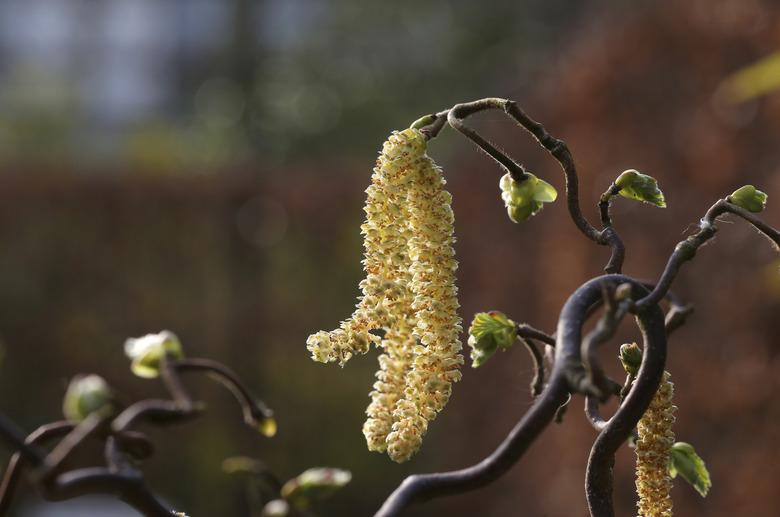How To Grow Contorted Filbert
Contorted filbert (Corylus avellana "Contorta") is named for its unusual, twisted stems, which are easiest to see in winter when the branches are bare; in spring, 2- to 3-inch-long yellowish-brown male flowers, called catkins, appear. In its preferred full- or partial-sun, well-drained sites, this large shrub or small tree requires little care, but it sometimes suffers from a fungal disease called eastern filbert blight. Contorted filbert grows in U.S. Department of Agriculture plant hardiness zones 4 through 8, usually reaching about 8 feet tall and wide.
Step 1
Contorted filbert tolerates a range of growing sites. An unfussy shrub, contorted filbert grows in sand, loam and clay soils, and tolerates acidic and slightly alkaline soil, but doesn't tolerate exposure to salt, such as on coastal sites or runoff from roads that are salted in icy conditions in winter. Contorted filbert won't grow in full shade, but partial shade conditions are fine. Grow contorted filbert next to a deck, patio, path or water feature, where the twisted stems can be appreciated in winter, and grow it out of the range of other shrubs and trees, so that the stems aren't mixed in with other branches. Space contorted filbert plants 36 to 60 inches apart. There's no need to fertilize this shrub when growing it in the ground.
Watering Needs
Step 1
Young contorted filbert plants need regular watering, but watering is reduced as the plants mature. Water contorted filbert regularly during the first year, applying 10 gallons of water for every 1 inch of the trunk's diameter at knee height at each watering. Water the tree three times a month in dry weather while the tree is in leaf. Spray the water evenly over the ground within the tree's drip line, using a soft spray attachment on a garden hose. You can find out the amount of time your hose takes to supply 10 gallons of water by timing how long it takes to fill a 5-gallon bucket and doubling the time. Spread a 2-inch layer of leaf mold, shredded bark or other mulch around the tree to conserve soil moisture, but leave a gap around the trunk to avoid encouraging rot. Established contorted hazel trees tolerate drought but benefit from watering when the ground is dry to a depth of 3 inches.
Step 2
- Contorted filbert tolerates a range of growing sites.
- Contorted filbert won't grow in full shade, but partial shade conditions are fine.
Pruning Contorted Filbert
Step 1
Suckers that appear on a contorted filbert should be pruned, and you can also improve the shrub's appearance by shaping it. Suckers are shoots that grow from roots, and suckers that appear on contorted hazel plants grow straight, not twisted. If they're left to grow and develop, they can dominate the plant. Sterilize your pruning shears by wiping the blades with a cloth soaked in rubbing alcohol, and prune suckers as close to the ground as possible whenever they appear. To open out the center of a contorted hazel and shape the tree, prune dead, damaged, crossing and congested stems, cutting where they join the rest of the tree. This is easiest to do when the branches are bare. Sterilize your pruning shears again when you've finished.
Step 2
- Suckers that appear on a contorted filbert should be pruned, and you can also improve the shrub's appearance by shaping it.
Controlling Filbert Blight
Step 1
Few pests or diseases cause long-lasting damage to contorted filbert, but eastern filbert blight causes serious harm. A disease caused by the fungus Anisogramma anomala, eastern filbert blight causes swollen, distorted and cracked bark, and eventually spreads over the whole tree, killing it. Examine contorted filbert shrubs regularly for signs of the disease, and prune affected stems 5 or 6 inches below the diseased area, using sterilized pruning shears. Sterilize the shears between each cut and after use. If the disease reaches the trunk there is no cure and the tree should be dug up and disposed of. Eastern filbert blight occurs in most places contorted filbert grows, including western areas of the United States.
